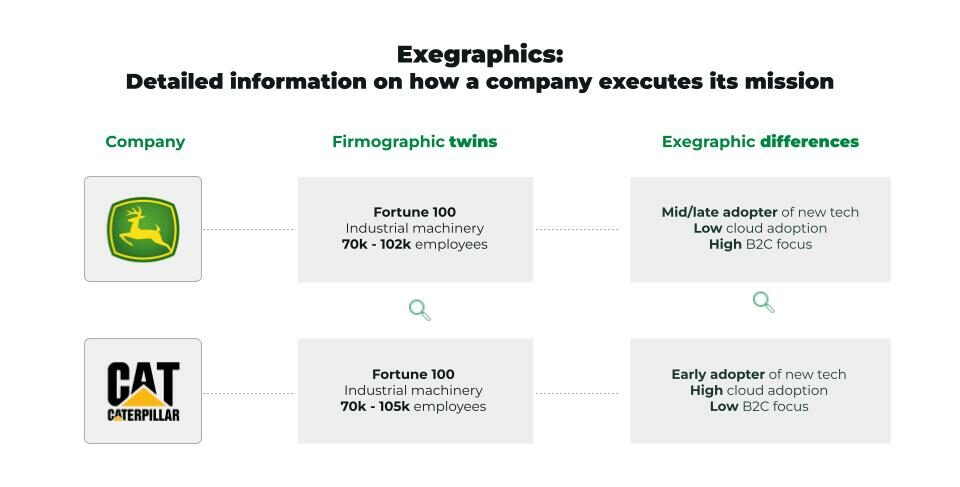Ever wondered how RevOps teams truly measure their success? In a recent survey, 72% of RevOps teams highlighted revenue as their primary metric for success.
While revenue is undoubtedly a crucial metric, there’s more to it than meets the eye. In fact, RevOps teams are evaluated based on a diverse range of factors that go beyond the dollars and cents.
In this blog post, we’ll explore the other metrics and KPIs your team should prioritize. By understanding these essential metrics and KPIs, your team will be able to effectively communicate their contributions to not only revenue growth but also the organization’s broader objectives.
We’ll also introduce you to the power of exegraphic data—insights into how companies operate and behave—to elevate your metrics and KPIs.
Let’s get started!
Revenue operations metrics vs. KPIs
By using RevOps metrics and KPIs together, RevOps teams can showcase the comprehensive picture of their impact. While the terms are often used interchangeably, recognizing their distinction is crucial for showcasing the true value of RevOps efforts.
RevOps metrics: The foundation of performance measurement
RevOps metrics are the quantifiable data points that track and assess various aspects of revenue operations. These metrics provide specific insights into the performance and efficiency of different processes within the RevOps function.
RevOps KPIs: Aligning revenue operations with strategic business objectives
On the other hand, KPIs are a subset of RevOps metrics that have been strategically chosen to align with the broader goals and objectives of the organization. KPIs serve as high-level performance indicators, providing a snapshot of progress toward strategic targets.
The power of both for demonstrating impact and value
By using RevOps metrics and KPIs together, RevOps teams can showcase the comprehensive picture of their impact. RevOps metrics provide the foundation for evaluating performance and identifying areas for improvement, while KPIs highlight the key indicators that align with the organization’s goals.
This combination enables RevOps teams to effectively communicate how their work drives revenue growth, operational efficiency and customer success—ultimately solidifying their role as a valuable strategic function within the organization.
18 RevOps metrics and KPIs that demonstrate impact and value
Let’s explore the revenue operations metrics and KPIs that can help provide a comprehensive view of how your team contributes to revenue growth and aligns with the organization’s broader objectives.
9 RevOps metrics
#1 Aim
Building a high-quality, high-efficiency pipeline is at the heart of what RevOps sets out to solve, and that starts with improving your aim, the percent of the accounts in your pipeline that match your ICP. Our research shows that only 18% of most organizations’ pipelines are filled with accounts that have the traits they care about most. That’s why digging into the data, tracking it and improving it is key to seeing a lift on everything downstream—and down to your bottom line.
#2 Revenue retention
Retaining existing customers is crucial for long-term success. Revenue retention metrics help RevOps teams understand how well they keep customers and their associated revenue. It’s a way to gauge customer satisfaction and identify areas for improvement to reduce churn.
#3 Customer acquisition cost (CAC)
Acquiring new customers comes at a cost, and keeping tabs on the expenses involved is important. CAC metrics allow RevOps teams to assess the average cost incurred to acquire a single customer. By optimizing customer acquisition strategies, RevOps teams can ensure efficient resource allocation and maximize ROI.
#4 Sales pipeline velocity
The speed at which opportunities move through the sales pipeline is a key metric for RevOps teams. It helps them identify bottlenecks and optimize the sales process. By tracking pipeline velocity, RevOps teams can improve overall revenue generation and ensure timely deal closures.
#5 Customer churn rate
Churn rate indicates the percentage of customers who leave or stop using your products or services. RevOps teams can use churn rate metrics to understand customer satisfaction and loyalty. It’s also an opportunity to implement retention strategies and minimize revenue loss.
#6 Sales forecasting
RevOps teams should collaborate with sales teams to analyze historical data and market trends, ensuring more accurate sales forecasts. This allows for better resource allocation and smarter decision-making.
#7 Account expansion
RevOps teams can track metrics related to account expansion, such as customer renewals, upgrades and cross-sells. By focusing on these areas, RevOps teams can drive revenue growth and increase customer lifetime value.
#8 Conversion rate
Conversion rate metrics help assess the effectiveness of marketing and sales efforts in turning leads into customers. By optimizing conversion rates, RevOps teams can maximize revenue generation and improve the overall customer journey.
#9 Cost-per-lead
Cost-per-lead metrics help assess the efficiency of marketing campaigns and lead generation strategies. By optimizing costs, RevOps teams can improve ROI and make better resource allocation decisions.
9 RevOps KPIs
While revenue operations metrics provide valuable insights into the performance of RevOps teams, key performance indicators (KPIs) offer a more robust picture of the strategic objectives and outcomes tied to revenue growth, operational efficiency and customer success.
Let’s explore some of the most important revenue operations KPIs that RevOps teams should prioritize.
#1 Customer lifetime value (CLV)
CLV measures the average revenue generated from a customer throughout their entire journey with your company. It highlights RevOps teams’ efforts in building strong relationships and maximizing revenue from each customer, whether through repeat business, cross-selling or upselling.
#2 Win rate
Win rate measures the percentage of sales opportunities that turn into closed deals. A solid win rate indicates how effective RevOps is in optimizing the sales process and helping the organization win more business. It’s a testament to their behind-the-scenes support in driving revenue.
#3 Customer satisfaction score (CSAT)
CSAT measures how satisfied our customers are based on surveys or feedback. By measuring CSAT, RevOps can gauge how satisfied customers are and pinpoint areas for improvement.
#4 Time to resolution
RevOps teams aim to minimize the time it takes to address customer issues or support tickets. By tackling problems promptly, they contribute to maintaining happy customers and smooth operations.
#5 Sales cycle length
RevOps teams work behind the scenes, streamlining operations to shorten the time for a lead to become a closed deal. By optimizing the sales journey, RevOps teams ensure faster and more effective conversions, allowing the organization to capitalize on opportunities swiftly and drive revenue growth.
#6 Lead response time
By being prompt and providing timely assistance, RevOps teams significantly enhance the chances of securing conversions. Their focus on delivering exceptional customer experiences right from the initial touchpoint sets a strong foundation for building positive relationships and driving revenue growth.
#7 Net promoter score (NPS)
NPS measures customer loyalty and the customer’s likelihood of recommending the company. RevOps efforts in improving NPS scores reflect their dedication to delivering exceptional experiences and driving growth through customer advocacy.
#8 Forecast accuracy
Accurate revenue forecasting is a critical aspect of RevOps teams’ responsibilities. By analyzing data and using advanced forecasting techniques, they provide reliable revenue projections that enable the company to plan effectively.
With a solid grasp of future revenue streams, RevOps teams help the organization make informed decisions, allocate resources strategically and optimize operational efficiency.
#9 New net growth
By tracking new net growth, RevOps teams assess the effectiveness of their customer acquisition strategies, retention efforts and overall business growth. It allows them to identify opportunities for expanding the customer base, optimizing revenue generation and driving sustainable growth.
How to use exegraphics to elevate revenue operations metrics and KPIs
Exegraphics—data on how companies operate and behave—can transform how revenue operations teams approach their metrics and KPIs. By delving into the inner workings of companies, exegraphics provide valuable insights that can drive revenue growth.
How exactly? Let’s explore three specific examples.
Example 1: Invest resources on the best-fit accounts
A lot of outbound strategies rely on guesswork. You go after companies you think fit your ICP, at least the superficial markers you can see—like industry, company size etc. But there’s more to a great-fit prospect than meets the eye, and that’s where exegraphics come in. Exegraphics can uncover the deeper characteristics that really matter to you, so you can identify all the companies that share those traits and focus your attention on closing those accounts rather than working accounts that will never close.
For example, take a look at the exegraphic difference between John Deere and CAT.

Example 2: Generate more account expansion opportunities
With exegraphics, you can identify target accounts that closely resemble your high-value customers, allowing you to tailor your account expansion strategies effectively.
By understanding the characteristics shared by your best customers, you can prioritize opportunities for upselling, cross-selling and expanding customer relationships.
This targeted approach increases the likelihood of success, boosting revenue through increased account expansion.
Example 3: Accelerate sales pipeline velocity
Exegraphics can help you better understand how companies function internally, enabling you to identify bottlenecks and streamline processes.
Armed with this knowledge, you can align resources more effectively, accelerate the movement of deals through the pipeline and shorten sales cycles.
As a result, you can generate revenue faster, capitalize on opportunities and achieve greater overall sales efficiency.
Example 4: Reduce customer churn
Exegraphics can also provide insights into how companies project themselves to the world, helping you understand their messaging, value proposition and positioning.
You can leverage this knowledge to develop targeted retention strategies that address specific pain points, improve customer satisfaction and reduce churn rates.
By proactively engaging with customers based on their unique characteristics and needs, you can foster loyalty, enhance customer relationships and drive sustainable revenue growth.
7 tips for demonstrating the impact of RevOps on key business objectives
Here are seven tips to help you effectively communicate the value of the metrics and KPIs in a meeting.
Set the context
Begin by emphasizing the organization’s overarching objectives, such as driving revenue growth and enhancing customer satisfaction. Let the management team know that RevOps KPIs are instrumental in achieving these goals.
Connect the dots
Clearly articulate the direct correlation between each KPI and its impact on the business outcomes. For instance, customer lifetime value (CLV) directly influences long-term revenue generation, while win rate reflects the team’s ability to convert sales opportunities into closed deals.
Be customer-centric
Highlight how KPIs like customer satisfaction score (CSAT) and net promoter score (NPS) provide insights into customer sentiment and loyalty. Explain that, by improving these scores, the organization can foster stronger customer relationships. This improvement, in turn, can lead to higher retention rates and positive word-of-mouth referrals.
Quantify the impact
Use concrete examples and data to illustrate the financial impact of these KPIs. Share statistics on potential revenue growth resulting from incremental improvements in win rates or the potential gains from increasing CLV through upselling and cross-selling initiatives.
Tell success stories
Share real-life success stories or case studies that demonstrate the tangible outcomes achieved by focusing on these KPIs. Highlight specific examples where the team’s efforts led to revenue growth, enhanced customer satisfaction or improved operational efficiency.
Align with company vision
Connect the dots between the discussed KPIs and the organization’s broader vision, mission and strategic goals. Demonstrate how tracking and improving these metrics align with the company’s long-term objectives and contribute to its overall success.
Visual aids for impact
Use visually appealing charts, graphs, or dashboards to present the KPI data in an engaging and accessible manner. Visuals help stakeholders grasp key insights quickly and make a lasting impression.
Final thoughts
By tracking and leveraging the right revenue operations metrics and KPIs, you can ensure that the impact of your revenue operations team’s work is effectively communicated and understood.
Incorporating exegraphics can also help you take those metrics and KPIs to new heights and enhance how you identify and target your next best customers!
Want to see the power of exegraphics for yourself? Contact us to schedule a demo of Rev, and we’ll show you the exegraphics behind your best customers and give you a free target account list of companies that look just like them.

